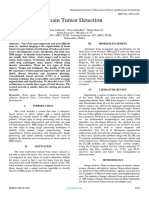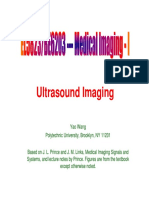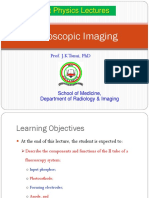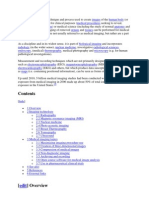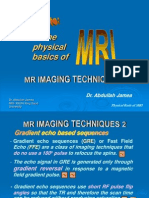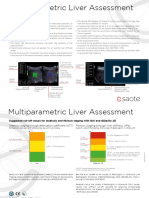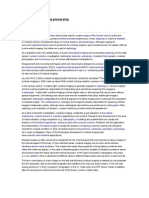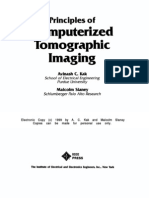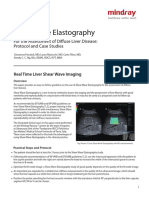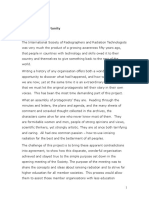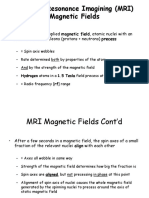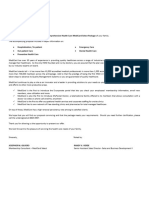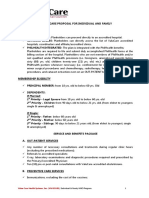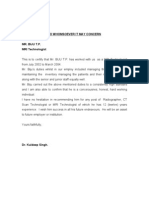Principles of the MRI Signal
Contrast Mechanisms
MR Image Formation
John VanMeter, Ph.D.
Center for Functional and Molecular Imaging
Georgetown University Medical Center
Outline
Physics behind MRI
Basis of the MRI signal
Tissue Contrast
Examples
Spatial Localization
Properties of Electrical
Fields
S
+
N
Properties of Magnetic
Fields
S
Magnetic Resonance
Imaging
Hydrogen protons spin
producing a magnetic
field
A magnetic field
spinning
proton
creates an electrical
charge when it rotates
past a coil of wire
N
S
bar
magnet
Similarity between a
proton and a bar magnet
Randomly oriented
protons
Protons aligned with a
strong magnetic field
Bo
net magnetic
moment is zero
Mo
net magnetic
moment is
positive
The
MRI
Measurement
S
N
Effect of Static Field on
Protons
Bo
Net magnetization
Precession in Magnetic
Field
Bo
Head Coil (Birdcage)
Spin Excitation
Tipping Protons into the Imaging
Plane
90o pulse
Flip Angle - Degree of
Deflection from Z-axis
z
y
x
90o Radiofrequency Pulse used
to tip protons into X-Y plane.
Magnetic Moment
Measurable After RF Pulse
Bo
Following an RF pulse the
protons precess in the x-y
plane
Mo
The MRI Measurement
(Up to this point)
In the presence of the static magnetic
field
Protons align with the field
Protons precess about the magnetic
Briefly turn on RF pulse
Provides energy to tip the protons at least
partially into the imaging plane
What happens to the protons next?
Types of Relaxation
Longitudinal precessing protons are pulled back
into alignment with main magnetic field of the
scanner (Bo) reducing size of the magnetic moment
vector in the x-y plane
Transverse precessing protons become out of
phase leading to a drop in the net magnetic moment
vector (Mo)
Transverse relaxation occurs much faster than
Longitudinal relaxation
Tissue contrast is determined by differences in these
two types of relaxation
Longitudinal Relaxation in
3D
Longitudinal Relaxation in
2D
90o
z
y
x
Free Induction Decay
Transverse
Relaxation
Wait time TE after excitation before
measuring M when the shorter T2 spins have
dephased.
z
z
y
y
vector
sum
initially
at t= TE
Transverse Relaxation
Bo
Mo
Transverse Relaxation
Bo
Mo
Transverse Relaxation
Bo
Mo
T1 and T2 relaxation
The MRI Measurement
RF
(Sans Spatial Localization)
time
Bo
z
z
Mo
y
x
Voltage
(Signal)
90
y
Mo
x
Mo
V(t)
time
ty
x
Main Tissue Contrast
Controls
Echo Time (TE) time after 90o RF
pulse until readout. Determines how
much transverse relaxation will occur
before reading one row of the image.
Repetition Time (TR) time between
successive 90o RF pulses. Determines
how much longitudinal relaxation will
occur before constructing the next row
of the image.
Tissue Contrast
Intensity
Intensity
Every tissue has a different affect
on longitudinal (T1) and transverse
(T2) relaxation.
Time
Time
T1 Curve
T2 Curve
Contrast in MRI: T1-Weighting
1.0
Signal
0.8
white matter
T1 = 600
gray matter
T1 = 1000
0.6
CSF
T1 = 3000
0.4
0.2
0.0
0
1000
2000
TR (milliseconds)
3000
Optimizing TR Value for T1
Contrast
Effect of Varying TR
T1-Weighting
CSF dark
WM bright
GM gray
Contrast in MRI: T2-Weighting
10
50
TE (milliseconds)
Optimizing TE Value for T2
Contrast
Effect of Varying TE
T2-Weighting
CSF (fluid)
bright
GM gray
WM dark
Contrast in MRI: Proton Density
Tissue with most protons
has highest signal and is
thus brightest in the
image
Proton Density Weighted
aka PDW
Summarizing Contrast
Two main knobs:
TR controls T1 weighting
TE controls T2 weighting
Longitudinal relaxation determines T1
contrast
Transverse relaxation determines T2
contrast
But Wait
How do you set TE to generate a
T1 weighted image?
How do you set TR to generate a
T2 weighted image?
How do you set TR & TE to
generate a proton density
weighted image?
Mixing T1 & T2 Contrast
What do you get if you use the
optimal TR setting for T1 contrast
and the optimal TE setting for T2
contrast?
T3 contrast?
No contrast!!
(time in 1000s of ms)
Tissue Contrast Dependence on TR, TE
Long
PDW
T2
TR
Short
T1
poor!
Short
TE
Long
(time in 10s of ms)
Damadians Discovery
Differential longitudinal relaxation
between healthy and tumorous
tissue in the rat
Walker sarcoma had longer T1
relaxation time than healthy brain
Novikoff Hepatoma had shorter T2
relaxation time than healthy liver
Two Main Classes of Pulse
Sequence
Spin Echo (SE) - uses a second RFpulse to refocus spins
TR & TE control T1 and T2 contrast
Gradient Echo (GE) - uses a gradient to
refocus spins
Flip Angle & TE control T1 and T2* contrast
Used in EPI (fMRI) sequences
T2*-Weighting (GE)
Refer to T2-weighting in a gradient
echo sequence as T2*-weighting
Because of inhomogeneities in the B0
magnetic field T2 relaxation occurs
faster using a gradient echo sequence
than true T2 relaxation as measured
with a spin-echo sequence
The greater the inhomogeneity the
faster T2 decay occurs
T2*-Weighting (GE) vs
T2-Weighting (SE)
T2* Effect
Well shimmed
Poorly shimmed
Venous Infarct
T1Weighted
T2Weighted
PDWeighted
Glioblastoma Multiforme
T1-Weighted
T2-Weighted
Cerebral Lymphoma
T1-Weighted
T2-Weighted
Anaplastic Astrocytoma
T1-Weighted
T2-Weighted
Multiple Sclerosis
The MRI
Experiment
time
RF
Voltage
(Signal)
time
Mo
Bo
90
z
Mo
y
x
Mo
V(t)
The MRI Sequence
(Sans Spatial
Localization)
1) Equilibrium (magnetization points along Bo)
2) RF Excitation
(tip magnetization away from equilibrium)
3) Precession produces signal, dephasing
starts
4) Readout signal from precession of the
magnetization vector (TE)
5) Return to equilibrium and reapply RF
Excitation (TR)
Spatial Localization
Gradients, linear change in magnetic
field, will provide additional information
needed to localize signal
Makes imaging possible/practical
Remember the Indomitable?
Couldnt spatially localize MRI signal instead
moved subject to get each voxel
Nobel prize awarded for this idea!
Larmor Equation
Frequency (rate) of precession is
proportional to the strength of
magnetic field
=*B
Dissecting Larmor
Equation
=*B
Rate of
precession
Magnetic field
Gyromagnetic Constant
Center Frequency
Center frequency is the frequency
(i.e. rate) at which protons spin
(precess) with just the static
magnetic field
If the center frequency of a 1.5T
scanner is 63MHz what it the
center frequency of our 3.0T
scanner?
Center Frequency
B
63MHz
If B = 1.5T
2 * 63MHz
If B = 3.0T
126MHz
Gradients
A gradient is simply a deliberate change in
the magnetic field
Gradients are used in MRI to linearly modify
the magnetic field from one point in space to
another
Gradients are applied along an axis (i.e. Gx
along the x-axis, Gy along the y-axis, Gz along
the z-axis)
What happens to the frequency at which the
precess when we turn on a gradient?
Effect of Gradient on Rate
of Precession
B= B0+ B1
-r
0 1 2 3 4 5 6 7 8 9 +r
Effect of a Gradient
From Proton Signal to
Pixel Intensities
Amplitude of the sinusoidal wave
at a pixel used to determine the
brightness of the pixel (i.e. color)
Signal from Multiple Pixels
Pixel 1
.
.
.
Pixel n
Net
Signal
at Coil
Decomposing Received
Signal
Left unchanged the signal received
cannot be broken down by location of
individual pixels
Need method for efficiently pulling out
the signal from many pixels at once
Gradients used to relate where a
particular signal is coming from
Frequency Encoding
Use a gradient to modify the rate
at which the protons spin based on
location of the proton
Requires the gradient to remain on
Uniform
Field
Col 1
Col 2
Col 3
Uniform
Field
Prior to Gradient
Lower
Field
Col 1
Col 2
Col 3
Higher
Field
Gradient Applied
Frequency Encoding
Apply gradient in one direction and
leave it on
Result:
Protons that experience a decrease in
the net magnetic field precess slower
Protons that experience an increase
in the net magnetic field precess
faster
Side-Effect of Gradient
Gradient also
causes phase of
the protons to
change
Application of a
second gradient of
opposite polarity
will undo this
Frequency Encode
Gradient
The area
under the
second
gradient
must be
equal to that
of the first
gradient
Phase Encoding
Turn gradient on briefly then turn it off
Turning on the gradient will cause some
protons to spin faster others to spin
slower depending on where they are
located
Turning off the gradient will make them
all spin at the same rate again
BUT they will be out of phase with one
another based on where they are located
Phase Encoding
Uniform
Field
Row 1
Row 2
Row 3
Uniform
Field
Prior to Gradient
Lower
Field
Row 1
Row 2
Row 3
Higher
Field
Gradient Applied
Uniform
Field
Row 1
Row 2
Row 3
Uniform
Field
Gradient Turned Off
Phase Encoding
Apply gradient in one direction briefly
and then turn off
Result:
Protons initially decrease or increase their
rate of precession
After the gradient is turned off all of the
protons will again precess at the same rate
Difference is that they will be out phase
with one another
Combining Phase &
Frequency Encoding
Row 1,
Col 1
Row 2,
Col 2
Row 3,
Col 3
Sum Corresponds to
Received Signal
Row 1, Col
1
Row 2, Col
2
Row 3, Col
3
+
+
Converting Received
Signal into an Image
Signal produced using both
frequency and phase encoding can
be decomposed using a
mathematical technique called the
Inverse Fourier Transform
Result is the signal (sinusoidal
squiggles) produced at each
individual pixel
Row 1, Col
1
Row 2, Col
2
Row 3, Col
3
From Signal to Image
Inv FFT
Pixels
Lauterburs Insight
Use of gradients to provide spatial
encoding
Frequency and Phase - was
Lauterburs contribution
Awarded Nobel prize for this work
k-space
Pseudo
Time
Components of Frequency
Domain
Three components to a signal in the
frequency domain:
Amplitude
Frequency
Phase
comes from contrast
rate at which protons spin
direction of protons spin
Inverse Fourier Transform (IFT) is a
mathematical tool for converting data from
frequency domain to image domain
k-space
Frequency increases
from the center out
in all directions
Phase varies by
angle
Images From k-space
K-space is turned into an image
using a Fourier Transformation
2D-IFT
Center of k-space
2D-IFT
Everything Else
2D-IFT
Full Frequency Half
Phase
2D-IFT
Selecting a Slice
Again use gradient to modify frequency of the
protons spin
Slice select gradient is positive on one side of the
slice and negative on the other side
At the desired slice location the slice select
gradient is zero
Thus, protons in this slice and only this slice will be
spinning at the center frequency of the scanner!
If this gradient is on when we apply RF pulse only
protons in the slice will be tipped into x-y plane
and thus measurable
Slice Select Gradient
Slice Thickness vs
Gradient Strength
Slice Orientation
Putting it All Together
Basic Pulse Sequence Diagram
EPI pulse sequence and kspace trajectory
Signal loss due to
susceptibility artifacts in
GRE EPI images
Magnetic Susceptibility Greater on T2*
than T2 Images
Spin
Echo (T2)
Gradient
Echo (T2*)
Oxygenated
Hemoglobin
Deoxygenated
Hemoglobin
Effects of field variation
upon EPI images
Effects of field variation
upon EPI images
Spiral imaging
Susceptibility artifacts in
spiral images
Effects of field variation on
spiral images
Effects of field variation on
spiral images
Acquisition Matrix
Size
64 x 64 Matrix
64 x 128 Matrix
128 x 128 Matrix
Isotropic (square)
Anisotropic
(oblong)
Isotropic (square)
Relative SNR = 1
Relative SNR =
0.5
Relative SNR =
0.25
MRI Image
Acquisition
Constraints
Signal
to Noise Ratio
Spatial
Resolution
Temporal
Resolution




